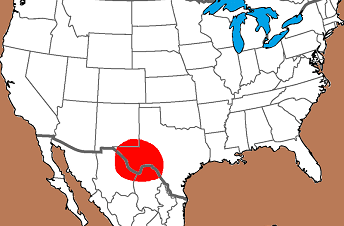
Identified By: Robert J. Mallouf
Named For: Alazan Hills, Presidio County, Texas
Date Identified: 2009
Type Site:
Mallouf is a distinguished anthropologist who has served as the State Archaeologist for the State of Texas, Assistant Professor and Senior Archaeologist at Sul Ross State University in Texas. This point was named in a professional publication and has limited professional references. This is considered a provisional type.
Total Length - 15 to 35 mm, Stem Length - 4 to 70 mm, Blade Width - 12 to 15 mm, Neck Width - 4 to 6 mm, Basal Width - 6 to 10 mm (***based on small sample size***)
Loyd Doty reports:
ALAZAN (True Arrowhead) – is Spanish meaning ‘sorrel’ as in the sorrel plant which has arrowhead shaped leaves. This point type was identified by Jack Hendrick during surveys near Van Horn, Culberson County, Texas, but remained unnamed until Robert J. Mallouf provisionally assigned the name for examples recovered from sites in the Alazan Hills in Presidio County. They are small (1” to 1 ¼”) projectiles with sharp tips, serrated blade edges, barbed shoulders and short stems with deeply concaved bases. They are related culturally to the Livermore. Distribution includes the Big Bend region of Texas and they were in use from the Mississippian to Late Woodland period.
Reference: Robert J. Mallouf 2009, 2012:16-21, Big Bend's Ancient & Modern Past: Compilation of Articles Originally Published in the Journal of Big Bend. College Station, Texas A&M University Press.

This point is primarily found in the eastern Trans Pecos region and the Big Bend region of Texas. Mallouf (2013) notes that this type occurs in the Terlingua Creek, Bear Creek, Glass Mountains, Big Canyon, Chisos Mountains, Maravillas Creek, and Persimmon Gap areas of the Big Bend Proper.” He also notes that they “appear to have an increasing frequency to the north, being known from the Davis Mountains, Y-6 Hills, Lobo Valley, and Plateau areas.” and into the Guadalupe Mountains, Delaware Mountains, and Salt Basin areas
Date: 850 - 650 B.P.
Cultural Period: Late Prehistoric
Glacial Period: Medieval Warm
Culture: Livermore culture

